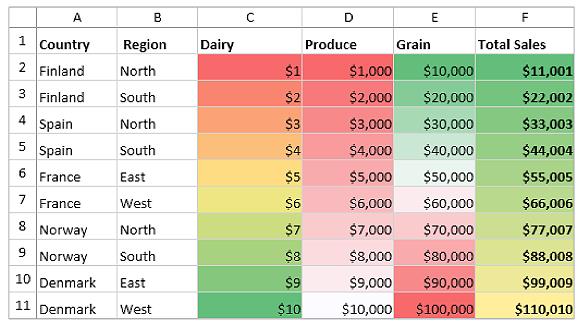Conditional Formatting in WPF Spreadsheet (SfSpreadsheet)
6 Aug 20256 minutes to read
This section explains about how to apply conditional formatting rules programmatically at run time in SfSpreadsheet.
In SfSpreadsheet, to apply conditional format for a cell or range of cells, add IConditionalFormat to that range by using AddCondition method.
var worksheet =spreadsheet.Workbook.Worksheets[0];
IConditionalFormats condition = worksheet.Range["A1"].ConditionalFormats;
IConditionalFormat condition1 = condition.AddCondition();Highlight Cell Rules
Based on CellValue
To format the cells based on cell value, define the conditional format type as CellValue and other formatting options such as formula, operator, background color etc., to the specified cell or range. Finally, invalidate the cells to refresh the view.
var worksheet = spreadsheet.Workbook.Worksheets[0];
IConditionalFormats condition = worksheet.Range["A1:A100"].ConditionalFormats;
IConditionalFormat condition1 = condition.AddCondition();
condition1.FormatType = ExcelCFType.CellValue;
condition1.Operator = ExcelComparisonOperator.Greater;
condition1.FirstFormula = "10";
condition1.BackColor = ExcelKnownColors.Light_orange;
spreadsheet.ActiveGrid.InvalidateCell(GridRangeInfo.Col(1));Based on Formula or Cell References
To format the cells based on Formula or Cell References, define the conditional format type as Formula and other formatting options such as formula, background color etc., to the specified cell or range. Finally, invalidate the cells to refresh the view.
var worksheet = spreadsheet.Workbook.Worksheets[0];
IConditionalFormats condition = worksheet.Range["A1:A100"].ConditionalFormats;
IConditionalFormat condition1 = condition.AddCondition();
condition1.FormatType = ExcelCFType.Formula;
condition1.FirstFormula = "=(B1+B2)>50";
condition1.BackColor = ExcelKnownColors.Brown;
spreadsheet.ActiveGrid.InvalidateCell(GridRangeInfo.Col(1));Based on SpecificText
To format the cells based on specified text, define the conditional format type as SpecificText and other formatting options such as the particular text, operator, background color etc., to the specified cell or range. Finally, invalidate the cells to refresh the view.
var worksheet = spreadsheet.Workbook.Worksheets[0];
IConditionalFormats condition = worksheet.Range["A1:A100"].ConditionalFormats;
IConditionalFormat condition1 = condition.AddCondition();
condition1.FormatType = ExcelCFType.SpecificText;
condition1.Text = "SYNC";
condition1.Operator = ExcelComparisonOperator.ContainsText;
condition1.BackColor = ExcelKnownColors.Light_orange;
spreadsheet.ActiveGrid.InvalidateCell(GridRangeInfo.Col(1));Based on TimePeriod
To format the cells based on time period, define the conditional format type as TimePeriod and other formatting options such as the time periods for the date, operator, background color etc., to the specified cell or range. Finally, invalidate the cells to refresh the view.
var worksheet = spreadsheet.Workbook.Worksheets[0];
IConditionalFormats condition = worksheet.Range["A1:A100"].ConditionalFormats;
IConditionalFormat condition1 = condition.AddCondition();
condition1.FormatType = ExcelCFType.TimePeriod;
condition1.TimePeriodType = CFTimePeriods.Today
condition1.BackColor = ExcelKnownColors.Light_orange;
spreadsheet.ActiveGrid.InvalidateCell(GridRangeInfo.Col(1));Sample Output

Data Bars
To apply the conditional format based on data bars,define the conditional format type as a DataBar and specify the properties associated with DataBars such as bar color, MinPoint, MaxPoint etc.,.to the specified cell or range. Finally, invalidate that cells to update the view.
var worksheet = spreadsheet.Workbook.Worksheets[0];
var conditionalFormats = worksheet.Range["B1:B100"].ConditionalFormats;
var conditionalFormat = conditionalFormats.AddCondition();
conditionalFormat.FormatType = ExcelCFType.DataBar;
conditionalFormat.DataBar.BarColor = Color.FromArgb(255, 214, 0, 123);
conditionalFormat.DataBar.MinPoint.Type = ConditionValueType.LowestValue;
conditionalFormat.DataBar.MaxPoint.Type = ConditionValueType.HighestValue;
spreadsheet.ActiveGrid.InvalidateCell(GridRangeInfo.Col(2));Sample Output

Color Scales
To apply the conditional format based on color scales, define the conditional format type as a ColorScale and specify the other properties associated with ColorScale such as condition count,color criteria etc.,to the specified cell or range. Finally,invalidate that cells to update the view.
var worksheet = spreadsheet.Workbook.Worksheets[0];
var conditionalFormats = worksheet.Range["C2:C100"].ConditionalFormats;
var conditionalFormat = conditionalFormats.AddCondition();
conditionalFormat.FormatType = ExcelCFType.ColorScale;
conditionalFormat.ColorScale.SetConditionCount(2);
conditionalFormat.ColorScale.Criteria[0].FormatColorRGB = Color.FromArgb(255, 99, 190, 123);
conditionalFormat.ColorScale.Criteria[1].FormatColorRGB = Color.FromArgb(255, 90, 138, 198);
spreadsheet.ActiveGrid.InvalidateCell(GridRangeInfo.Col(3));Sample Output

Icon Sets
To apply the conditional format for Icon sets, define the conditional format type as IconSet and the properties associated with IconSet such as the type of the icon,criteria etc., to the specified cell or range. Finally, invalidate that cells to update the view.
vvar worksheet = spreadsheet.Workbook.Worksheets[0];
var conditionalFormats = worksheet.Range["D2:D100"].ConditionalFormats;
var conditionalFormat = conditionalFormats.AddCondition();
conditionalFormat.FormatType = ExcelCFType.IconSet;
conditionalFormat.IconSet.IconSet = ExcelIconSetType.ThreeSymbols;
spreadsheet.ActiveGrid.InvalidateCell(GridRangeInfo.Col(4));Sample Output
![]()
NOTE
You can refer to our WPF Spreadsheet feature tour page for its groundbreaking feature representations. You can also explore our WPF Spreadsheet example to know how to render and configure the spreadsheet.